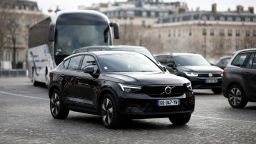Editor’s Note: David A. Andelman, a contributor to CNN, twice winner of the Deadline Club Award, is a chevalier of the French Legion of Honor, author of “A Red Line in the Sand: Diplomacy, Strategy, and the History of Wars That Might Still Happen” and blogs at SubStack’s Andelman Unleashed. He formerly was a foreign correspondent and bureau chief for The New York Times in Europe and Asia and for CBS News in Paris. The views expressed in this commentary are his own. View more opinion at CNN.
Imagine this: no new gas-powered cars for sale 11 years from now. Zero carbon emissions 15 years after that. That’s not news from another planet. That’s what Europeans are facing as of this moment, chiseled into law by European Union countries.

On Sunday, Parisians voted underwhelmingly (barely 78,000 out of 1 million eligible residents cast their ballots) to triple parking fees on gas guzzling SUVs on Sundays in their beloved city.
It’s one small step on a continent that’s poised to turn a very different kind of corner compared to that of the US.
The fact is that gas cars aren’t being weaponized on most of the continent the way they are in America. They are quite simply disappearing, or about to do so. Those cars that are left in Europe are being confined to ever narrower corridors.
By the middle of this year, private cars will be gone entirely from the center of Milan, Italy’s second largest city and its financial capital. “We’ll start with the center, but then we will expand,” Mayor Giuseppe Sala said late last year.
Likewise, in the Swedish capital Stockholm, gas and diesel cars will be banned from 20 blocks of its most desirable inner city shopping and office area from next year. And already in Austria’s capital in October, our taxi couldn’t get closer than a block from our hotel on the Stephansplatz square in central Vienna.
Other European cities have been banning cars for decades. In Pontevedra, northwestern Spain, there hasn’t been a single private car in most of the city since 1999. The last road fatality came 13 years ago when a delivery van ran over an 81-year-old pedestrian.
In Paris, all heck is likely to break loose this summer. That’s when the Olympics descend on the French capital, and much of the center city will become inaccessible to most motorized traffic. “We are not saying that people should leave Paris,” the city’s police chief Laurent Nunez told a press conference in November, adding that there would be exemptions for emergency vehicles and residents. “Pedestrians are allowed everywhere,” he said.
But then, there’s the aftermath. Oh dear.
Take the Place de la Concorde. King Louis XVI and Marie Antoinette were guillotined there during the French Revolution. Now, after the Olympics, “The place given to the car in this emblematic place will have been only a parenthesis in history,” said Mayor Anne Hidalgo earlier this year. In other words: half of the surface area of the Place “will not be returned to motorists after the Olympic Games,” she said.
For years, Hidalgo has made it her mission to tackle Paris’s traffic pollution – banning cars from the banks of the River Seine and expanding pedestrian and bike lanes on a host of other thoroughfares. But doing so has also scrunched cars into ever narrower stretches, compacting the city’s already congested streets.
None of this is to suggest, of course, that reducing auto emissions worldwide is not a central element of controlling the global warming that is causing havoc to our planet. I’m all in favor of the commendable end to gas cars that Europe has now embraced – a decade or more hence. But in reality, doing this in dribs and drabs seems to be making it longer, more difficult, or more expensive, to get around than it used to be in a whole lot of cities where infrastructure has failed to keep pace with innovation.
Try getting to one of my favorite restaurants, Bofinger, off the Bastille from my apartment around the corner from the Musée d’Orsay at lunch time. Forever. And watching that taxi meter tick up and up and up. Or sit in the bus, rarely with air conditioning, in 90 degree heat. (Hidalgo doesn’t even want the Olympic village for athletes to have AC, in an effort to be environmentally friendly).
Of course, that’s only one corner of what’s happened to Paris traffic under the Hidalgo regime. I still remember the good old days in Paris, when it was possible to take the fast routes along the quays by the Seine – limited entry, limited exits – to race across the city at 60 miles an hour from the Maison de Radio far out in the 16th arrondissement past the islands of the Seine and on virtually to the Bastille in the 4th in minutes even at the height of rush hour. Ditto along the “left” bank of the Seine. No longer.
Now, all cars are crammed into nearby city streets. Taxis, buses, delivery vans and the remaining private cars jostle for space. Many of them are about to go up in a puff of smoke as well. Hidalgo plans on new restrictions on much of central Paris from Notre Dame to the islands of the Seine, by some estimates taking 100,000 cars off the road daily.
It’s going, it would seem, a lot slower across the pond. In the same year that the EU plans to end sales of all new gas-powered cars – 2035 – the US government alone, under an order from President Joe Biden, plans to stop buying them. (The US government owns more than 650,000 vehicles and purchases around 50,000 each year).
And that’s three years earlier than some US cities. Last October, New York Mayor Eric Adams signed into law a requirement that beginning in 2038, all city-owned vehicles would have to be electric. No end in sight for gas-powered cars in America, at least not in the near future. The nation’s love affair with the automobile is ineluctable.
Are my seriously asthmatic lungs likely to be breathing any better during the months I spend these days in Paris? Not on your life, or mine. The same toxic, planet-warming emissions are being generated, especially with all that idling in place in endless traffic jams.
A Sunday parking fee for gas guzzlers is an ephemera. Perhaps a couple of decades from now when all those gas guzzling cars will be gone entirely? Of course, by then I’ll be pushing 100.





